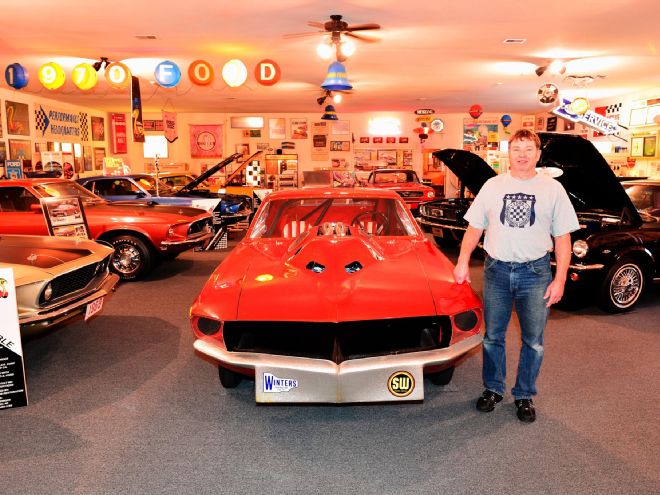
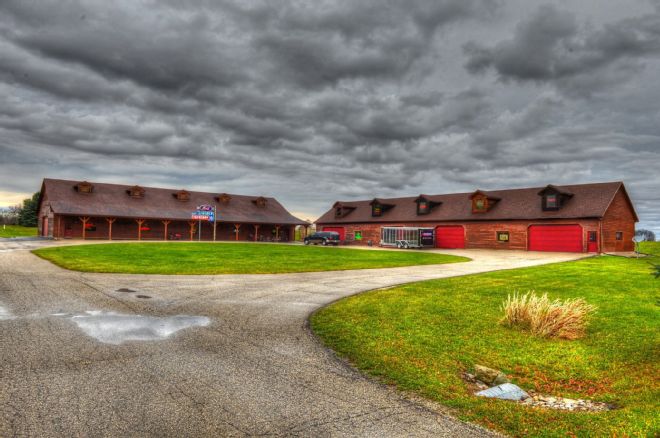 Perkins Restoration consists of two big buildings. On the left is the showroom; on the right is the restoration shop. Both buildings have attics dedicated to parts and literature.
Perkins Restoration consists of two big buildings. On the left is the showroom; on the right is the restoration shop. Both buildings have attics dedicated to parts and literature.
Restoring a Mustang is not an inexpensive proposition, especially when the goal is to have a show-stopping, Thoroughbred award-winning car. Obviously, the nicer and more complete the car to begin with, the less you’ll spend to restore it. Regardless, it’s going to be a major investment to do it right. That’s why it’s vital to choose your restoration shop as carefully as possible.
One of the most highly respected restoration experts in the business is Bob Perkins (who also happens to write the “Resto Roundup” column in this magazine). Perkins sat down with us recently to go over 10 things people need to look out for when choosing a restoration shop. Now obviously, Perkins has his own Mustang restoration shop, so his opinions might be a bit biased, and there are exceptions to most of the rules here. However, the waiting list to have a car restored at Perkins Restoration is long he doesn’t need to solicit business here. These are the things he has noticed during his decades of experience at the top of the Mustang restoration pyramid. So if you find a shop that scores 10 out of 10 on this list, there’s a good chance your project will end up done just the way you like on the first go ’round.
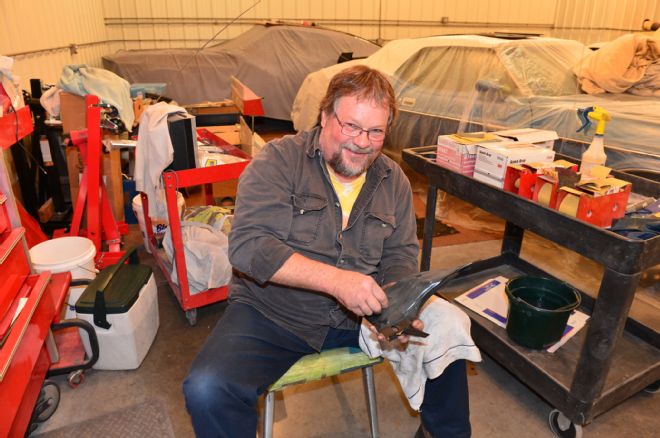 Inside the shop, we found Laehr picky-sanding a part.
Inside the shop, we found Laehr picky-sanding a part.
Sign #1: If you go into a restoration shop and can’t find a paint booth…
Verdict: You might not be in a real restoration shop
Paint and bodywork represent 50 to 60 percent of the total hours spent on an entire restoration. Therefore, a customer’s car will spend as much, or more, time in the paint and body shop as it does in the restoration shop. A typical restoration consumes 1,000-plus hours, which means the paint and bodywork amount to 500 to 600 hours at a minimum, more if the body needs major work.
Without a paint booth in the resto shop, you might find your Boss 429 has been sent out to Joe Blow’s paint shop in a bad part of town and for a very long time. That’s known as “paint jail.” How can a restoration shop make any money if they farm out more than half its work to another paint shop? How high can they jack up the cost of another shop’s paintjob? A fair person might assume the markup won’t be that high, but some restoration shops earn more money with a pencil than a paint gun.
Plus, the question of liability arises. Who is responsible for issues like repayment of losses if, for instance, Joe Blow’s paint shop burns down? Is the car covered with that shop’s insurance? What if somebody steals your car from the paint shop? “Many times I’ve heard customers ask, ‘Hey, I got this national show winner and the paint is starting to fail,” Perkins said. “Who is going to warranty the paintjob?’ Well, the restoration shop is going to blame this on the paint shop. And when the customer says, ‘I paid you for the paintjob and you should be responsible. I don’t know who this Joe Blow is. He might tell me to go jump in the lake.’” Having the entire restoration done by a single shop negates those types problems.
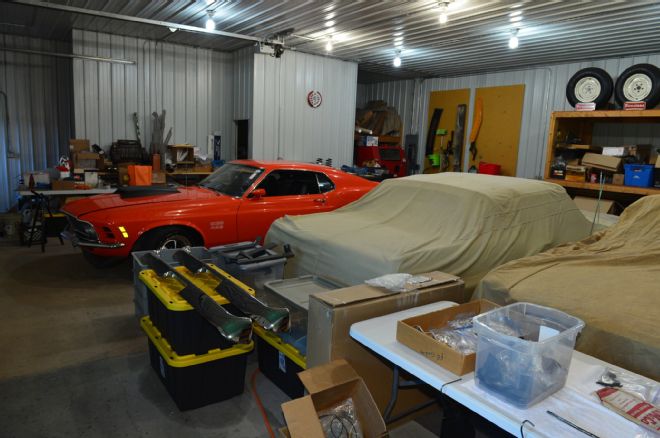 This section of the shop is the “bullpen,” where cars await their turn in the restoration rotation. The Boss 429 on the left was in Perkins’s shop for detailing. The two under covers on the right are in for ground-up restorations.
This section of the shop is the “bullpen,” where cars await their turn in the restoration rotation. The Boss 429 on the left was in Perkins’s shop for detailing. The two under covers on the right are in for ground-up restorations.
Sign #2: If you go into a restoration shop and it is doing mostly assembly work…
Verdict: You might not be in a real restoration shop
This is similar to Sign #1. When a restoration shop farms out more and more restoration work, including engine building, upholstery, suspension, and more, that shop becomes more of a contractor and assembly shop than a restoration shop. “I have a hard time calling an assembly shop a restoration shop,” Perkins said. The car owner might just as well save $50 to $100 an hour and farm-out his own restoration, eliminating the expensive middleman.
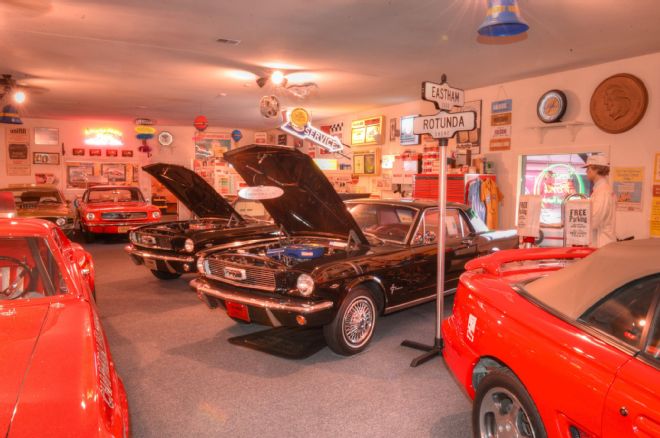 Perkins owns all the cars in the showroom, with the exception of one customer car.
Perkins owns all the cars in the showroom, with the exception of one customer car.
Sign #3: If you go into a restoration shop and find only one employee at a workbench…
Verdict: You might be in a real restoration shop
That’s what we saw inside Bob Perkins Restoration. Tim Laehr was tapping on a radiator on a workbench, taking great pride in getting that radiator pounded out just right. That’s because a guy like Laehr, Perkins’ sole full-time employee, is literally an artist in Oshkosh by Gosh attire. “I don’t think I could find 25 Tim Laehrs in the Midwest to work on cars, it’s not going to happen.” Perkins said. “And you can’t control quality if the shop is too big.”
According to Perkins, he and Laehr do pretty much everything except engine machine work. Though they do assemble the engines on a stand and start them up to make sure everything’s right. “We have our own engine break-in stand with the gauges and gas where we can run the motor before it ever goes in the car to test for leaks.” Of course, they also do paint and bodywork, upholstery, suspension, literally the entire car in a real restoration shop.
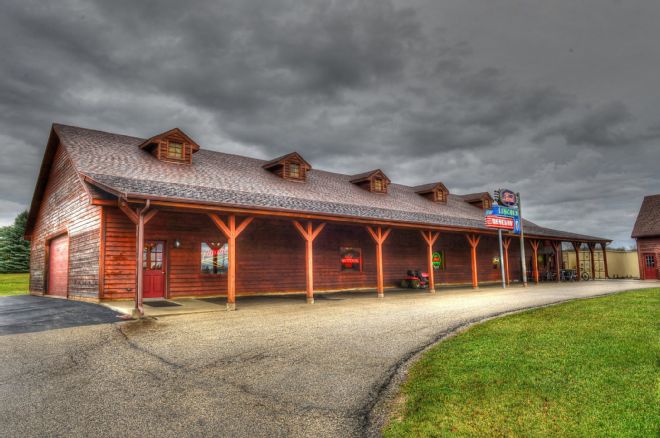 Located in rural Wisconsin, Perkins Restoration is a destination connoisseurs must research to discover the location.
Located in rural Wisconsin, Perkins Restoration is a destination connoisseurs must research to discover the location.
Sign #4: If you go into a restoration shop and find an employee on his cell phone calling for help…
Verdict: You might not be in a real restoration shop
Several years ago, a restoration shop employee told us how much research he did while restoring a car. And yes, he charged the typical hourly rate to do that research. “That’s one of my pet peeves,” Perkins said. “If you are a specialty shop for Mustangs or Shelbys, or both, why should the customer pay for your learning curve?”
Some restoration shops charge from $50 to $100 per hour for an employee to sit down in an office and call up different experts for restoration information or to hunt parts. Those phone calls, at $100 per hour, add up to some very expensive toll charges.
Interestingly, while we were talking to Perkins about this very subject, he got a call from a restoration shop looking for advice. The man said he had 10 questions he needed to ask about restoring a 1971 Boss 351. Later, he laughed out loud when he mentioned what one of his customers told him, “You know, Bob, maybe you ought to get a 900 number.”
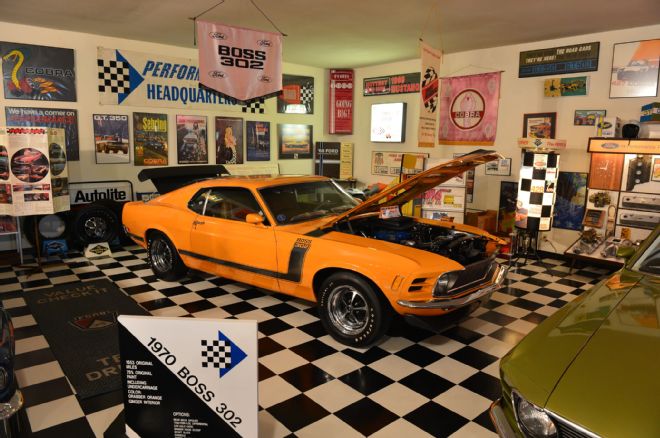 Maybe the best Boss 302 in the world is Perkins’ 1,500-mile 1970 model, seen here in a Ford Performance Corner dealer showroom setting.
Maybe the best Boss 302 in the world is Perkins’ 1,500-mile 1970 model, seen here in a Ford Performance Corner dealer showroom setting.
Sign #5: If you go into a restoration shop and find a showroom full of the kind of cars the shop is restoring, along with show car awards, and magazine articles glued to big boards…
Verdict: You might be in a real restoration shop
If the shop owner collects and restores the same cars that his customers are bringing to him, he obviously has a passion for them. The passion is a sure sign the owner restores cars for more than just money. Money is secondary with restorers who are enthusiasts like their customers. This shop owner will most likely trailer his cars to shows and will have awards displayed that he and his customers have won. If the customer is asking this shop to restore his car to Thoroughbred status, find out how many national Thoroughbred show winners this shop produced in the last 10 to 15 years.
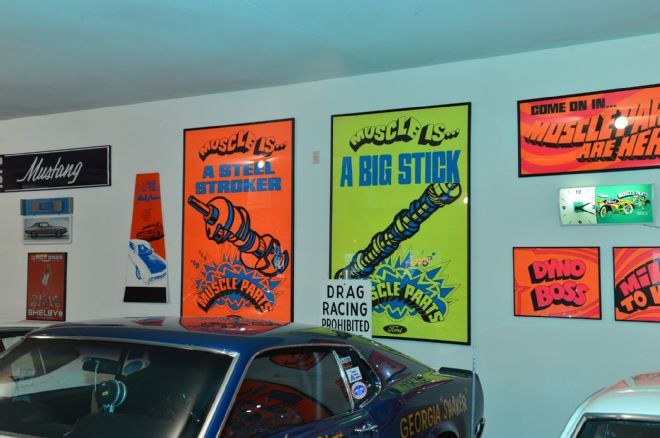 Perkins is partial to all first-generation Mustangs.
Perkins is partial to all first-generation Mustangs.
Sign #6: If you go into a restoration shop and find cars started but none finished…
Verdict: You might not be in a real restoration shop
Most likely, this shop has charged down-payment money on each car and started on its restorations. According to Perkins, “You might see several cars that are started, but nothing close to being finished. Such as, six cars in primer that don’t look like they are getting past primer.” You may come back to the shop and hear stories of about the restorations. Perkins said, “If a body shop is working a Camaro, and six months later, a ’Cuda, a Firebird, and some late-model collision work, there is not the same passion.”
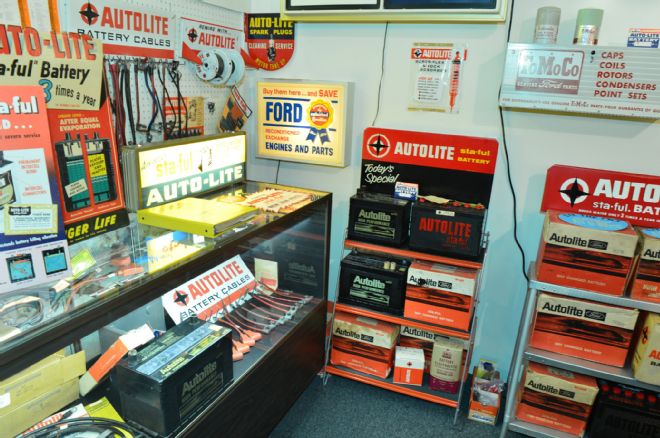 Autolite parts anyone? Perkins has the goods, as well as the glass cases.
Autolite parts anyone? Perkins has the goods, as well as the glass cases.
Sign #7: If you go into a restoration shop and get on a waiting list…
Verdict: You might be in a real restoration shop
The top restoration shops are busy for a reason. As a result, customers usually have to wait one to two years to make it into the restoration rotation. In this case, when you go into the shop you will see cars waiting to be restored, in various stages of restoration, and several finished cars. The cars are in these various stages because the shop is using all its facilities. Having two or three cars on the rotisserie at the same time would not be efficient. But, one undergoing disassembly, one on the rotisserie, one ready for paint, and one in final assembly, shows a progression of completion, and is a sign of a real restoration shop. It should almost look like an assembly line. “And you might see two to three cars ready to go to the Nationals,” Perkins added.
 Original showroom posters and banners adorn showroom walls.
Original showroom posters and banners adorn showroom walls.
Sign #8: If you go into a restoration shop and they get you in right away and take a deposit…
Verdict: You might not be in a real restoration shop
Shops with six cars in primer might be good at taking a deposit, and stripping a car to primer. These shops have you on a big hook with your car partially disassembled and undrivable—in other words—stuck. These same shops eagerly consent to do whatever you request without question. The customer asks for a concours restoration. “Yes, sir we do those.” A driver restoration for cruise night? “Of course, we can.” Base coat, clear coat? “Yes, we will.” Factory single-stage paint with orange peel? “Yes, we can. Rocker panels rusted out? “No problem.”
These shops are apt to make promises they cannot keep. They also tend to accept rougher cars that are beyond the capabilities of the paint and body shop they will farm the car out to. And then, when no shop can fix the corroded metal, the restoration stalls, and the restoration shop shifts blame to the outside body shop. “If a car needs floorpans that indicates all the bare metal stuff on the undercarriage is shot—from the rear leaf springs to the control arms—everything is going to be rusted and pitted,” Perkins said.
Shops with lesser credentials and expertise, and those shops that need work, take on rustier and rougher cars as starting points. This can easily put a customer upside down, meaning putting far more money into the car than it is worth. “That’s something you always want to caution the customer about,” Perkins said.
Regardless of the car’s ultimate value, though, some cars have great sentimental value. For instance, a parent or grandparent who bought the car new and price is no object when it comes to restoring the car. Good restoration shops go over these good and bad points with customers, whereas a lesser shop’s major concern is cashing your check.
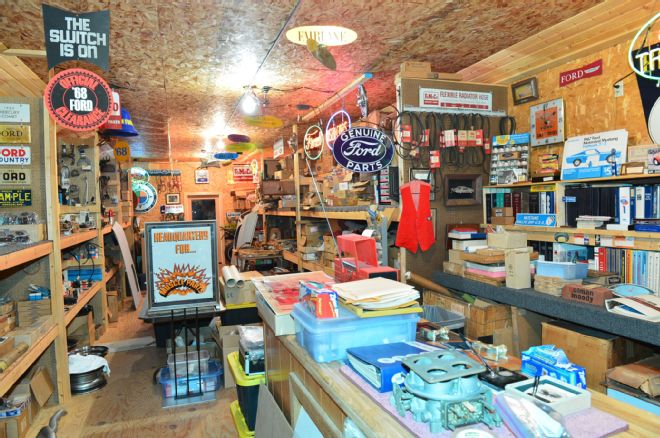 Here’s an indication of the original and NOS parts on-hand. Perkins has visited over 3,000 Ford dealers over the years, dating back to the early 1980s, in his pursuit of original parts.
Here’s an indication of the original and NOS parts on-hand. Perkins has visited over 3,000 Ford dealers over the years, dating back to the early 1980s, in his pursuit of original parts.
Sign #9: If you go into a restoration shop and they are very specific on what they can and cannot do…
Verdict: You might be in a real restoration shop
Real restoration shops specialize, they how to do restorations a specific way. Perkins Restoration refuses to do anything that isn’t stock in their restorations. They want to restore cars to Thoroughbred standards. “We don’t do paintjobs without orange peel. If you want base-coat or clear-coat, you must go somewhere else,” Perkins said.
Perkins usually turns down extremely rusty cars because he’s looking to restore to Thoroughbred standards, which requires a better starting point. If you haven’t figured it out yet, Perkins and other great restoration shops work on only the cream of the crop of Mustangs.
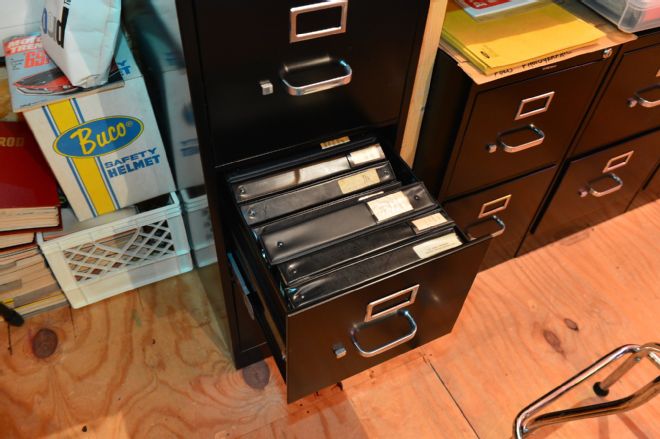 In addition to original factory assembly manuals, Perkins has factory files from Kar Kraft on final assembly for the 1969 and 1970 Boss 429.
In addition to original factory assembly manuals, Perkins has factory files from Kar Kraft on final assembly for the 1969 and 1970 Boss 429.
#10: If you go into a restoration shop and find a stash of original parts and manuals…
Verdict: You might be in a real restoration shop
Restoration is an intensive exercise. Serious restoration shops have already been there and done that restoring the cars they love, and enthusiasts who love cars also love the parts that make them up. “I hate to hunt parts when I’m restoring a car. I don’t even like to walk up to the attic to retrieve a part,” Perkins said.
Restoration shops hang on to their original parts, especially NOS parts, which they buy primarily for future restorations. Factory assembly manuals are also very helpful. With the one caveat, the restoration shop doesn’t depend on solely one source. They speak with odd lingo: “They did things differently at Metuchen and San Jose, and that’s going to be a contrast to the Dearborn assembly manuals.”
Assembly manuals impress with the factory nomenclature for the various parts, but real restoration shops are driven for perfection. For example, “if on March 25th the manufacturers were supposed to change a strut rod bushing kit on Boss 429s, there is no guarantee this change didn’t happen three days or two weeks later.” Restoration shops realize restoring cars is not cut and dry and assembly manuals are not the absolute authority thanks to running changes in production. They are a great guide, but not the final word on the way things were done.